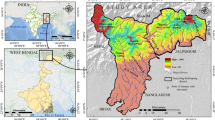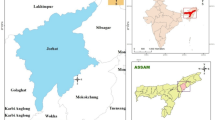Abstract
Groundwater is the most reliable source of fresh water. Due to several criteria such as increased population, urbanization, and industrialization, the groundwater sources are under severe threat. Climate change plays a vital role in the quality and quantity of groundwater sources. Also, the climate variability severely affects the parameters influencing the groundwater recharge. Unreliable monsoons and poor quality of the surface water resources tend to increase the decline in the groundwater levels. Hence, it is necessary to identify and delineate the groundwater potential zone (GWP) which can be used to augment the groundwater source. The study is carried out for Kancheepuram district where the groundwater serves as the main source for domestic and agricultural purposes rather than the surface water. The parameters such as topography, geology, drainage density, geomorphology, soil, land use and land cover rainfall, and the lineament density are generated as different layers in the GIS background and are subjected to weighted overlay analysis to obtain the potential zones of groundwater. The weights for the various layers were generated using the multi-criteria decision-making technique and analytical hierarchy process which allows the pairwise comparison of criteria influencing the potential zone. Further, the GWP map has been reclassified into five different classes, namely very high, high, moderate, low, and very low. The results of the study revealed that the very high potential zone comprises 12.68% (546.82 km2), high 25.07% (1081.30 km2), moderate 28.79% (1242.04 km2), low 22.97% (990.96 km2), and very low 10.50% (452.83 km2), respectively. In addition, the results validated using well yield data and pre-monsoon and post-monsoon water level data were found to have a good correlation with the same. Future management plans including natural and artificial recharge practice can be effectively made in these areas as reliable results were obtained with the methodology adopted.















Similar content being viewed by others
References
Abuzied SM, Yuan M, Ibrahim SK et al (2015) Delineation of groundwater potential zones in Nuweiba Area (Egypt) using remote sensing and GIS techniques. Int J Signal Process Syst 4:203–214. https://doi.org/10.12720/ijsps.4.2.109-117
Agarwal E, Agarwal R, Garg RD, Garg PK (2013) Delineation of groundwater potential zone: an AHP/ANP approach. J Earth Syst Sci 122:887–898. https://doi.org/10.1007/s12040-013-0309-8
Aggarwal M, Saravanan S, Jennifer JJ, Abijith D (2019) Advances in remote sensing and geo informatics applications. Springer, New York
Anbarasu S, Brindha K, Elango L (2019) Multi-influencing factor method for delineation of groundwater potential zones using remote sensing and GIS techniques in the western part of Perambalur district, Southern India. Earth Sci Inf. https://doi.org/10.1007/s12145-019-00426-8
Aneesh R, Deka PC (2015) Groundwater potential recharge zonation of bengaluru urban district—a GIS based analytic hierarchy process (AHP) technique approach. Int Adv Res J Sci Eng Technol 2:129–136. https://doi.org/10.17148/IARJSET.2015.2628
Arivalagan S, Kiruthika AM, Sureshbabu S (2014) Delineation of groundwater potential zones using Rs and Gis techniques: a case study for eastern part of Krishnagiri district. Tamilnadu 8354:51–59
Arkoprovo B, Adarsa J, Prakash SS (2012) Delineation of groundwater potential zones using satellite remote sensing and geographic information system techniques: a case study from Ganjam district, Orissa. India Res J Recent Sci 1:59
Arulbalaji P, Padmalal D, Sreelash K (2019) GIS and AHP techniques based delineation of groundwater potential zones: a case study from Southern Western Ghats. India Sci Rep. https://doi.org/10.1038/s41598-019-38567-x
Bagyaraj M, Ramkumar T, Venkatramanan S, Gurugnanam B (2013) Application of remote sensing and GIS analysis for identifying groundwater potential zone in parts of Kodaikanal Taluk, South India. Front Earth Sci 7:65–75. https://doi.org/10.1007/s11707-012-0347-6
Chandio IA, Matori ANB, WanYusof KB et al (2013) GIS-based analytic hierarchy process as a multicriteria decision analysis instrument: a review. Arab J Geosci 6:3059–3066. https://doi.org/10.1007/s12517-012-0568-8
Chaudhary BS, Kumar S (2018) Identification of groundwater potential zones using remote sensing and GIS of KJ Watershed, India. J Geol Soc India 91(6):717–721
Dar MA, Sankar K, Dar IA (2010) Groundwater prospects evaluation-based on hydrogeomorphological mapping: a case study in Kancheepuram district, Tamil Nadu. J Indian Soc Remote Sens 38:333–343. https://doi.org/10.1007/s12524-010-0022-x
Das B, Pal SC, Malik S, Chakrabortty R (2019) Modeling groundwater potential zones of Puruliya district, West Bengal, India using remote sensing and GIS techniques. Geol Ecol Landscapes 3(3):223–237
Dinesan VP, Gopinath G, Ashitha MK (2015) Application of geoinformatics for the delineation of groundwater prospects zones—a case study for Melattur Grama Panchayat in Kerala, India. Aquat Proc 4:1389–1396. https://doi.org/10.1016/j.aqpro.2015.02.180
Gebrie T, Getachew G (2019) Journal of Hydrology: Regional studies groundwater potential assessment using gis and remote sensing: a case study of Guna tana landscape, upper blue Nile Basin. Ethiopia J Hydrol Reg Stud 24:100610. https://doi.org/10.1016/j.ejrh.2019.100610
Gnanachandrasamy G, Zhou Y, Bagyaraj M, Venkatramanan S, Ramkumar T, Wang S (2018) Remote sensing and GIS based groundwater potential zone mapping in Ariyalur District, Tamil Nadu. J Geol Soc India 92(4):484–490
Gupta D, Yadav S, Tyagi D, Tomar L (2018) Multi-criteria decision analysis for identifying of groundwater potential sites in Haridwar, vol 3, pp 9–15
Hossein A, Ardakani H, Ekhtesasi MR (2016) Groundwater potentiality through analytic hierarchy process (AHP) using remote sensing and geographic information system (GIS). JGeope 6:75–88
Ibrahim-Bathis K, Ahmed SA (2016) Geospatial technology for delineating groundwater potential zones in Doddahalla watershed of Chitradurga district, India. Egypt J Remote Sens Sp Sci 19:223–234. https://doi.org/10.1016/j.ejrs.2016.06.002
Lakshmi SV, Kumar KS (2018) Identification of groundwater potential zones in kancheepuram using remote sensing and GIS. Int J Pure Appl Math 119(17):3185–3194
Ministry of Water Resources (2009) Third census of minor irrigation schemes. Government of India, New Delhi
Murmu P, Kumar M, Lal D, Sonker I, Singh SK (2019) Delineation of groundwater potential zones using geospatial techniques and analytical hierarchy process in Dumka district, Jharkhand, India. Groundwater Sustain Dev 9:100239
Pani S, Chakrabarty A, Bhadury S (2016) Groundwater potential zone identification by analytical hierarchy process (Ahp) weighted overlay in GIS environment—a case study of Jhargram. Int J Remote Sens Geosci 5:1–10
Patil SG, Mohite NM (2014) Identification of groundwater recharge potential zones for a watershed using remote sensing and GIS. Int J Geomatics Geosci 4:485–498
Pinto D, Shrestha S, Babel MS, Ninsawat S (2017) Delineation of groundwater potential zones in the Comoro watershed, Timor Leste using GIS, remote sensing and analytic hierarchy process (AHP) technique. Appl Water Sci 7:503–519. https://doi.org/10.1007/s13201-015-0270-6
Ramu MB, Vinay M (2014) Identification of ground water potential zones using GIS and remote sensing techniques: a case study of Mysore taluk, Karnataka. Int J Geomat Geosci 5:393–403
Rao NS (2017) Groundwater potential index in a crystalline terrain using remote sensing data. Environ Geol. https://doi.org/10.1007/s00254-006-0280-7
Saravanan S (2012) Identification of artificial recharge sites in a hard rock terrain using remote sensing and GIS. Int J Earth Sci Eng 5(6):0974–5904
Saaty TL (2008) Decision making with the analytic hierarchy process. Int J Serv Sci 1(1):83
Savita RS, Mittal HK, Satishkumar U et al (2018) Delineation of groundwater potential zones using remote sensing and GIS techniques in Kanakanala reservoir subwatershed, Karnataka. Int J Curr Microbiol Appl Sci 7:273–288. https://doi.org/10.20546/ijcmas.2018.701.030
Shekhar S, Pandey AC (2015) Delineation of groundwater potential zone in hard rock terrain of India using remote sensing, geographical information system (GIS) and analytic hierarchy process (AHP) techniques. Geocarto Int 30:402–421. https://doi.org/10.1080/10106049.2014.894584
Siva G, Nasir N, Selvakumar R (2017) Delineation of groundwater potential zone in Sengipatti for Thanjavur District using analytical hierarchy process. IOP Conf Ser Earth Environ Sci. https://doi.org/10.1088/1755-1315/80/1/012063
Srinivasa Rao Y, Jugran DK (2003) Delineation of groundwater potential zones and zones of groundwater quality suitable for domestic purposes using remote sensing and GIS. Hydrol Sci J 48:821–834. https://doi.org/10.1623/hysj.48.5.821.51452
Sitender R (2010) Delineation of groundwater potential zones in Mewat District, Haryana, India. Int J Geomatics Geosci 2(1):270–281
Swain AK (2015) Delineation of groundwater potential zones in Coimbatore district, Tamil Nadu, using Remote sensing and GIS techniques. Int J Eng Res Gen Sci 3(6):203–214
Author information
Authors and Affiliations
Corresponding author
Additional information
Publisher's Note
Springer Nature remains neutral with regard to jurisdictional claims in published maps and institutional affiliations.
Rights and permissions
About this article
Cite this article
Saranya, T., Saravanan, S. Groundwater potential zone mapping using analytical hierarchy process (AHP) and GIS for Kancheepuram District, Tamilnadu, India. Model. Earth Syst. Environ. 6, 1105–1122 (2020). https://doi.org/10.1007/s40808-020-00744-7
Received:
Accepted:
Published:
Issue Date:
DOI: https://doi.org/10.1007/s40808-020-00744-7




